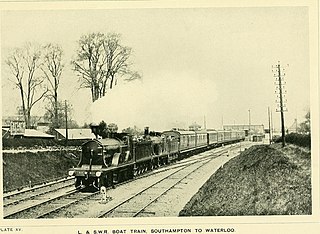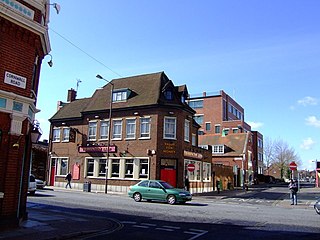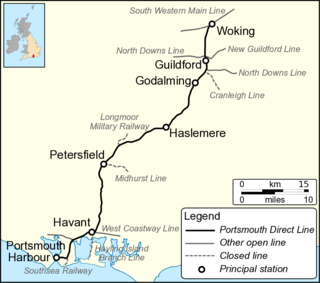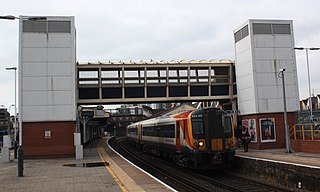
Portsmouth is a port and city in the county of Hampshire in southern England. The city of Portsmouth is a unitary authority, which is administered by Portsmouth City Council.

Southsea is a seaside resort and a geographic area of Portsmouth, Portsea Island in England. Southsea is located 1.8 miles (2.8 km) to the south of Portsmouth's inner city-centre. Southsea is not a separate town as all of Portsea Island's settlements were incorporated into the boundaries of Portsmouth in 1904.

The London and South Western Railway was a railway company in England from 1838 to 1922. Starting as the London and Southampton Railway, its network extended from London to Plymouth via Salisbury and Exeter, with branches to Ilfracombe and Padstow and via Southampton to Bournemouth and Weymouth. It also had many routes connecting towns in Hampshire and Berkshire, including Portsmouth and Reading. In the grouping of railways in 1923 the LSWR amalgamated with other railways to create the Southern Railway.

Priory School is a secondary school in Southsea, Hampshire, England. It is situated in the northern area of Southsea bordering Fratton, and lies close to Fratton railway station on the A2047. Stewart Vaughan is the Headteacher at the school. Priory school is an academy and part of the Bohunt Education Trust.

Portsea Island is a flat and low-lying natural island 24.5 square kilometres in area, just off the southern coast of Hampshire in England. Portsea Island contains the majority of the city of Portsmouth.

The London, Brighton and South Coast Railway was a railway company in the United Kingdom from 1846 to 1922. Its territory formed a rough triangle, with London at its apex, practically the whole coastline of Sussex as its base, and a large part of Surrey. It was bounded on its western side by the London and South Western Railway (L&SWR), which provided an alternative route to Portsmouth. On its eastern side the LB&SCR was bounded by the South Eastern Railway (SER)—later one component of the South Eastern and Chatham Railway (SE&CR)—which provided an alternative route to Bexhill, St Leonards-on-Sea, and Hastings. The LB&SCR had the most direct routes from London to the south coast seaside resorts of Brighton, Eastbourne, Worthing, Littlehampton and Bognor Regis, and to the ports of Newhaven and Shoreham-by-Sea. It served the inland towns and cities of Chichester, Horsham, East Grinstead and Lewes, and jointly served Croydon, Tunbridge Wells, Dorking and Guildford. At the London end was a complicated suburban and outer-suburban network of lines emanating from London Bridge and Victoria, and shared interests in two cross-London lines.

Fratton is a residential and formerly industrial area of Portsmouth in Hampshire, England. Victorian style terraced houses are dominant in the area, typical of most residential areas of Portsmouth. Fratton has many discount shops and "greasy spoon" cafes, as well as the Bridge Centre shopping centre containing an Asda.

Fratton Park is a football ground in Portsmouth, England, which is the home of Portsmouth F.C. Fratton Park remains as the only home football ground in Portsmouth FC's entire history.

The Portsmouth Direct line is a railway route between Woking in Surrey and Portsmouth Harbour in Hampshire, England. It forms the principal route for passenger trains between London and Portsmouth, and also provides a partial rail link to the Island Line on the Isle of Wight, with passengers disembarking at Portsmouth Harbour before taking the Wightlink catamaran service to Ryde Pier, where the Island Line commences at Ryde Pier Head. The name was derived unofficially, but has entered widespread use for the physical infrastructure between Woking and Portsmouth Harbour, and for the passenger train service from London over the route. The final section of line from Havant to Portsmouth is shared by other passenger routes.

Petersfield railway station serves the market town of Petersfield, Hampshire, England. It is on the Portsmouth Direct line, 54 miles 71 chains (88.3 km) down the line from London Waterloo via Woking.

Fratton railway station is a railway station in the city of Portsmouth, on Portsea Island in the United Kingdom. It was opened in the Fratton area of Portsmouth on 1 July 1885 as an interchange station between the London, Brighton and South Coast Railway and the short-lived Southsea Railway branchline.

The Southsea Railway was a branch of the Portsmouth Direct Line, located on Portsea Island, Hampshire in the United Kingdom. The railway was opened on 1 July 1885 and closed on 6 August 1914.

Portsmouth & Southsea railway station is a Grade II listed building and the main railway station in the Landport area of the city of Portsmouth in Hampshire, England. It is close to the Commercial Road shopping area. British Transport Police maintain a presence at the station. There is a taxi rank at the front of the building and regular local buses within five minutes' walking distance.

Littlehampton railway station is in Littlehampton in the county of West Sussex, England. The station and the trains serving it are operated by Southern, and at peak times also by Thameslink.

Copnor is an area of Portsmouth, England, located on the eastern side of Portsea Island. The population of Copnor Ward at the 2011 Census was 13,608. As Copenore, it was one of the three villages listed as being on Portsea Island in the Domesday book.
Milton is a residential area of the English city of Portsmouth, Hampshire, England, on the south eastern side of Portsea Island. Milton is bordered on the eastern coast of Portsea Island by Langstone Harbour, with Eastney to the south-east, Southsea to the south-west, Baffins to the north and Fratton to the north-west.

The Jersey Railway was opened in 1870 and was originally a standard gauge railway, 3+3⁄4 miles (6.0 km) long, in Jersey in the Channel Islands. Converted to narrow gauge in 1884 and extended giving a length of 7+3⁄4 miles (12.5 km), the line closed in 1936. It is not to be confused with the Jersey Eastern Railway.

Jessie Road Bridge Halt was an intermediate station situated on the Southsea Railway between Fratton and Albert Road Bridge Halt.

Albert Road Bridge Halt was an intermediate station situated on the Southsea Railway, between Jessie Road Bridge Halt and East Southsea.

The Portsmouth and Ryde Joint Railway was a group of three railway lines in Southern England that were jointly owned and operated by the London and South Western Railway and the London, Brighton and South Coast Railway. The main line was between Cosham and Portsmouth Harbour; there was a branch from Fratton to East Southsea; and a line between Ryde Pier Head and Ryde St John's Road. The last-named section was isolated from the others, being on the Isle of Wight. The first section of line opened in 1847 and the last in 1885; the Southsea branch closed in 1914 but all of the other routes have since been electrified and remain open.

















